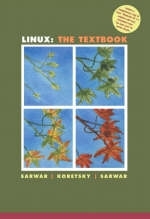
Linux
Pearson (Verlag)
978-0-201-72595-7 (ISBN)
- Titel ist leider vergriffen;
keine Neuauflage - Artikel merken
Linux: The Textbook is the first true textbook to teach the how and why of working in the Linux environment. Assuming no previous Linux experience, the book tours the Linux user interface to provide insight into the inner workings of the system as well as important Linux concepts. Readers are guided through Linux utilities for process, file, storage, and I/O management, thereby quickly learning to navigate the user interface while broadening their understanding of important operating system principles. This unique presentation—combined with a thorough and systematic coverage of Linux software development tools, Bash and TC shell programming, a glossary, a Linux installation appendix for Caldera, Mandrake, and Red Hat Linux, and a quick-reference appendix on commonly used shell commands and utilities—benefits the beginning student as well as the skilled Linux user.
(Each chapter concludes with a Summary and Problems.)
1. Overview of Operating Systems.
Introduction.
What is an Operating System?
Operating System Services.
Character Versus Graphical User Interfaces.
Types of Operating Systems.
The LINUX Family.
2. LINUX History.
Introduction.
Open Source Background.
Linus Torvalds.
LINUX Distributions.
Kernel History.
Popularity of LINUX.
Future Developments.
Web Resources.
3. Getting Started.
Introduction.
Computer System Hardware.
LINUX Software Architecture.
Logging On and Logging Off.
Correcting Command Line Typing Mistakes.
Some Important System Setups.
Some Useful Commands for the Beginner.
4. LINUX Shells.
Introduction.
Various LINUX Shells.
Some Useful General-Purpose Commands.
Shell Metacharacters.
5. Editing Text Files.
Introduction.
How to Do Short and Simple Edits by Using the pico Editor.
Obtaining More Control Using the vi Editor.
Getting Maximum Control by Using the emacs Editor.
How to do Graphical Editing by Using XEmacs.
Command Line Editing.
6. Electronic Mail.
Introduction.
How to Use the LINUX mail Command Effectively.
elm-A Full-Screen Display E-mail System.
pine-Another Full-Screen Display E-mail System.
Graphical E-mail with Kmail.
7. Files and File System Structure.
Introduction.
The LINUX File Concept.
Types of Files.
File System Structure.
Navigating the File Structure.
File Representation and Storage in LINUX.
Standard Files and File Descriptors.
End of File (eof) Marker.
8. File Security.
Introduction.
Password-Based Protection.
Encryption-Based Protection.
Protection-Based on Access Permission.
Determining and Changing File Access Privileges.
Special Access Bits 211.
File Permissions and Types.
9. Basic File Processing.
Introduction.
Viewing Contents of Text Files.
Copying, Moving, and Removing Files.
Appending to Files.
Combining Files.
Comparing Files.
Removing Repeated Lines.
Printing Files and Controlling Print Jobs.
10. Advanced File Processing.
Introduction.
Regular Expressions.
Compressing Files.
Sorting Files.
Searching for Commands and Files.
Searching Files.
Cutting and Pasting.
Encoding and Decoding.
Command History.
11. File Sharing.
Introduction.
Duplicate Shared Files.
Common Login for Members of a Team.
Setting Appropriate Access Permissions on Shared Files.
Common Group for Members of a Team.
File Sharing via Links.
Searching for Symbolic Links.
12. Redirection and Piping.
Introduction.
Standard Files.
Input Redirection.
Output Redirection.
Combining Input and Output Redirection.
I/O Redirection with File Descriptors.
Redirecting Standard Error.
Redirecting stdout and stderr in One Command.
Redirecting stdin, stdout, and stderr in One Command.
Redirecting Without Overwriting File Contents (Appending).
LINUX pipes.
Redirection and Piping Combined.
Error Redirection in the TC Shell.
Recap of I/O and Error Redirection.
13. Processes.
Introduction.
Running Multiple Processes Simultaneously.
LINUX Process States.
Execution of Shell Commands.
Process Attributes.
Process and Job Control.
Process Hierarchy in LINUX.
14. Networks and Internetworking.
Introduction.
Computer Networks and Internetworks.
The Reasons for Computer Networks and Internetworks.
Network Models.
The TCP/IP Protocol Suite.
Internet Services and Protocols.
The Client-Server Software Model.
Application Software.
15. Introductory Bash Programming.
Introduction.
Running a Bash Script.
Shell Variables and Related Commands.
Passing Arguments to Shell Scripts.
Comments and Program Headers.
Program Control Flow Commands.
16. Advanced Bash Programming.
Introduction.
Numeric Data Processing.
Array Processing.
The Here Document.
Interrupt (Signal) Processing.
The exec Command and File I/O.
Functions In Bash.
Debugging Shell Programs.
17. Introductory TC Shell Programming.
Introduction.
Running a TC Shell Script.
Shell Variables and Related Commands.
Passing Arguments to Shell Scripts.
Comments and Program Headers.
Program Control Commands.
18. Advanced TC Shell Programming.
Introduction.
Numeric Data Processing.
Array Processing.
The Here Document.
Interrupt (Signal) Processing.
Debugging Shell Programs.
19. File System Backup.
Introduction.
Archiving and Restoring Files Via tar.
Software Distributions in the tar Format.
20. LINUX Tools for Software Development.
Introduction.
Computer Programming Languages.
The Compilation Process.
The Software Engineering Life Cycle.
Program Generation Tools.
Static Analysis Tools.
Dynamic Analysis Tools.
21. Xfree86 and the LINUX GUI.
Introduction.
The Basics of Xfree86.
The GNOME Desktop Manager.
The KDE Desktop Manager.
Internet Resources.
Appendices.
A. LINUX Installation.
B. Command Dictionary.
C. Basic Administration.
| Erscheint lt. Verlag | 30.7.2001 |
|---|---|
| Sprache | englisch |
| Maße | 231 x 158 mm |
| Gewicht | 1266 g |
| Themenwelt | Informatik ► Betriebssysteme / Server ► Unix / Linux |
| ISBN-10 | 0-201-72595-9 / 0201725959 |
| ISBN-13 | 978-0-201-72595-7 / 9780201725957 |
| Zustand | Neuware |
| Haben Sie eine Frage zum Produkt? |
aus dem Bereich


